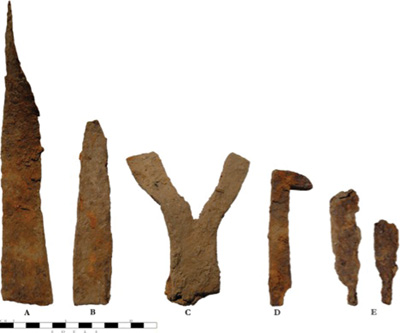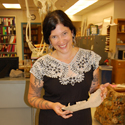Digging Jacksonville – December 2014/January 2015
The horseshoe is one of the quintessential artifacts of the American West. Not surprisingly, horseshoes like the one pictured here have been found in excavations across Jacksonville. In honor of long time Jacksonville resident Lewis Applebaker’s 100th birthday this month, I wanted to take this opportunity to feature this important artifact, and the blacksmiths who made them.
Blacksmiths in the nineteenth century were an important part of every western town. The ‘smithy,’ or the blacksmith shop, was where one could go for a number of services, including manufacturing and mending items associated with agriculture, transportation, and industry. Lewis’ dad, Joseph Applebaker, moved to Jacksonville from Wisconsin in the early 1900s, and set-up his blacksmith shop in an old gristmill he had moved down from south Third Street to its current location at Third and D Streets (the beautiful barn with the hex signs on the doors). Applebaker’s son recalled his father forge welding, shoeing horses, and building wagons and buggies, as “he was not only a blacksmith he was also what they called a wheelwright.” Lewis Applebaker helped his father in his blacksmith shop throughout the 1920s recalling:
I grew up as a kid in there. And Dad was shoeing horses and whatnot. There was a bench there and I set on that bench—I don’t know if my feet touched the ground or not. Dad would be welding—making a forge weld. He turned around to me and said, “Kid, I want a snowball heat.” You know, take it out and it was just sparkling. And blow harder, blow, blow, blow….
Blacksmithing continued to be an important service well into the twentieth century, although its function within communities would shift over time as blacksmithing served industrial more than individual needs. During the 1930s, Lewis’s brother, Theron, made $4.50 a day as a blacksmith at the Opp Quartz Mine just outside of town. The Applebaker brothers continued to occupy their dad’s old blacksmith shop, working as both mechanics and metal fabricators throughout the twentieth century.
In the spring of 2010, the City of Jacksonville and the Oregon Department of Transportation hit a cluster of horseshoes while digging a hole to transplant a small tree during the installation of the sidewalks along the north side of C Street. This location proved to be the site of one of the town’s earliest blacksmith shops, which was in operation roughly from 1853-1891. Over 100 horseshoes were pulled from the pit, along with a near-complete farrier’s tool kit. Lewis was able to help us identify many of these tools, as they would have been similar to those used by his father. When I asked Lewis what happened to his dad’s blacksmithing business, he told me:
Dad got old. Dad would go out in that shop and just putter around out there. The windows were broke out. It was cold, and he would bundle up, you know…he was in love with that old shop. And then, times changed…people would start driving cars. The horse and buggy days were over.
These artifacts from the old blacksmith shop on the corner of Fourth and C Street were part of a farrier’s tool kit. From left: A. Rasp File (used to clean and level the hoof). B. File (also used to clean and level the hoof). C. Fork (used by a blacksmith for bending rods and bars). D. Buffer (used to cut off the cinched ends of the nails in order to remove the old shoe). E. Drawing Knives (used to clean and trim the hoof in preparation for the shoe).


 Chelsea Rose is an historical archaeologist who specializes in the settlement and development of the American West. Chelsea and the Southern Oregon University Laboratory of Anthropology (SOULA) conduct archaeology across Oregon and have done several projects in Jacksonville. You can reach Chelsea at rosec@sou.edu and follow SOULA on
Chelsea Rose is an historical archaeologist who specializes in the settlement and development of the American West. Chelsea and the Southern Oregon University Laboratory of Anthropology (SOULA) conduct archaeology across Oregon and have done several projects in Jacksonville. You can reach Chelsea at rosec@sou.edu and follow SOULA on